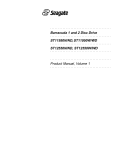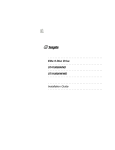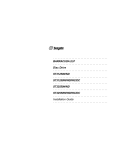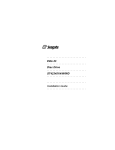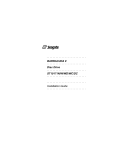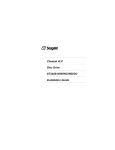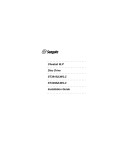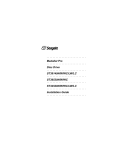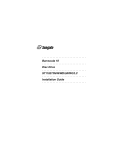Download Seagate BARRACUDA ST12550N/ND/W/WD Installation guide
Transcript
○ ○ ○ ○ ○ ○ ○ ○ ○ ○ ○ ○ ○ ○ ○ ○ ○ ○ ○ ○ ○ ○ ○ ○ ○ ○ ○ ○ ○ ○ ○ ○ ○ ○ ○ BARRACUDA 1 and 2 ○ ○ ○ ○ ○ ○ ○ ○ ○ ○ ○ ○ ○ ○ ○ ○ ○ ○ ○ ○ ○ ○ ○ ○ ○ ○ ○ ○ ○ ○ ○ ○ ○ ○ ○ ○ ○ ○ ○ ○ ○ ○ ○ ○ ○ ○ ○ ○ ○ ○ ○ ○ ○ ○ ○ ○ ○ ○ ○ ○ ○ ○ ○ ○ ○ ○ ○ ○ ○ ○ ○ ○ ○ ○ ○ ○ ○ ○ ○ ○ ○ ○ Disc Drive ○ ○ ○ ○ ○ ○ ○ ○ ST11950N/ND/W/WD ○ ○ ○ ○ ○ ○ ○ ○ ○ ○ ○ ○ ○ ○ ○ ST12550N/ND/W/WD ○ ○ ○ ○ ○ ○ ○ ○ ○ ○ ○ ○ ○ ○ ○ ○ ○ ○ ○ ○ ○ ○ ○ ○ ○ ○ ○ ○ ○ ○ ○ ○ ○ ○ ○ ○ ○ ○ ○ ○ ○ ○ ○ ○ ○ ○ ○ ○ ○ ○ ○ ○ ○ ○ ○ ○ ○ Installation Guide ○ ○ ○ ○ ○ ○ ○ ○ ○ ○ ○ ○ ○ Contents Preface .................................................................. Electrostatic discharge protection ........................... Important safety information and precautions ......... Wichtige Sicherheitshinweise ............................... Technical support services ..................................... General description ................................................ Initial setup information ........................................... Kühlung des Systems .......................................... Installation des Laufwerkes und Anschluß der Kabel ....................................... 1 1 2 5 10 12 19 36 39 © 1994 Seagate Technology, Inc. All rights reserved Publication Number: 83327770, Rev. D June 1994 Seagate®, Seagate Technology®, and the Seagate logo are registered trademarks of Seagate Technology, Inc. Barracuda™, SeaFAX™, SeaFONE™, SeaTDD™, and SeaBOARD™ are trademarks of Seagate Technology, Inc. Other product names are registered trademarks or trademarks of their owners. No part of this publication may be reproduced in any form without written permission from Seagate Technology, Inc. ST11950 and ST12550 Installation Guide, Rev. D 1 Preface This manual contains information for users of the Seagate® ST11950N/ND, ST11950W/WD, ST12550N/ND, and ST12550W/WD Barracuda™ SCSI disc drives. It provides support services, performance specifications, and initial setup information. Additional information is available in the Barracuda 1 and 2 Product Manual (part number 83327780). Contact your Seagate sales representative if you need to order this publication. Electrostatic discharge protection Caution. Removal of circuit boards by personnel not performing depot repair will damage components and may void the warranty. All drive electronic assemblies are sensitive to static electricity, due to the electrostatically sensitive devices used within the drive circuitry. Although some devices such as metal-oxide semiconductors are extremely sensitive, all semiconductors, as well as some resistors and capacitors, may be damaged or degraded by exposure to static electricity. Electrostatic damage to electronic devices may be caused by the direct discharge of a charged conductor or by exposure to the static fields surrounding charged objects. To avoid damaging drive electronic assemblies, observe the following precautions when installing or servicing the drive: 2 ST11950 and ST12550 Installation Guide, Rev. D • Ground yourself to the drive whenever the drive electronics are or will be exposed. Connect yourself to ground with a wrist strap (Seagate part number 12263496). Connection may be made to any grounded metal assembly. As a general rule, remember that you and the drive electronics must all be grounded to avoid potentially damaging static discharges. • Turn off the power before removing or installing the DC power cable. • Do not remove any circuit boards from the drive. • Never use an ohmmeter on any circuit boards. Important safety information and precautions Caution. Use forced-air ventilation when bench-testing the drive to ensure proper cooling of drive components. Use proper safety and repair techniques for safe, reliable operation of this unit. Service should be done only by qualified persons. We recommend the procedures in this manual as effective ways of servicing the unit. Some procedures require the use of special tools. For proper maintenance and safety, you must use these tools as recommended. The procedures in this manual and labels on the unit contain warnings and cautions that must be carefully ST11950 and ST12550 Installation Guide, Rev. D 3 read and followed to minimize or eliminate the risk of personal injury. The warnings point out conditions or practices that may endanger you or others. The cautions point out conditions or practices that may damage the unit, possibly making it unsafe for use. These warnings and cautions are not exhaustive. We cannot possibly know, evaluate, and advise you of all the ways in which maintenance might be performed or the possible risk of each technique. Consequently, we have not completed any such broad evaluation. If you use a non-approved procedure or tool, first ensure that the method you choose will not risk either your safety or unit performance. Always observe the following warnings and precautions: • Perform all maintenance by following the procedures in this manual. • Follow all cautions and warnings in the procedures. • Use sound safety practices when operating or repairing the unit. • Use caution when troubleshooting a unit that has voltages present. Turn off power to the unit before servicing it. • Wear safety shoes when removing or replacing heavy parts. 4 ST11950 and ST12550 Installation Guide, Rev. D • Ensure that the internal temperature of the rack or cabinet does not exceed the limits defined for the drive when the drive is mounted in an equipment rack or cabinet. When units are stacked vertically, pay attention to the top where temperatures are usually highest. • Follow the precautions listed above in “Electrostatic discharge protection.” • Do not remove any circuit boards from the drive chassis. Return the entire drive for depot repair if any circuit board is defective. Removal of circuit boards by personnel not performing depot repair will damage components and may void the warranty. • Do not remove the head and disc assembly (HDA) from the drive chassis. Return the entire drive for depot repair if the HDA is defective. • Do not attempt to disassemble the HDA. It is not field repairable. If the sealed HDA is opened by personnel not performing depot repair, this will damage components and void the warranty. As a component, this drive is designed to be installed and operated in accordance with UL1950, IEC950, EN60950, CSA C22.2 950, and VDE0805. Seagate takes all reasonable steps to ensure that its products are certifiable to currently accepted stan- ST11950 and ST12550 Installation Guide, Rev. D 5 dards. Typical applications of these disc drives include customer packaging and subsystem design. Safety agencies conditionally certify component parts, such as the Barracuda disc drive, based on their final acceptability in the end-use product. The subsystem designers are responsible for meeting these conditions of acceptability in obtaining safety/regulatory agency compliance in their end-use products and for certifying where required by law. A necessary part of meeting safety requirements is the provision for overcurrent protection on drive SELV supply voltages. This unit is a component assembly and as such is not meant to comply with FCC or similar national requirements as a stand-alone unit. Engineering radiated emissions test results are available through the Seagate Safety Department to assist the subsystem designer. Wichtige Sicherheitshinweise Vorsicht. Beim Testen des Laufwerks auf dem Prüftisch ist Fremdbelüftung vorzusehen, um eine ausreichende Kühlung der Laufwerkkomponenten sicherzustellen. Verwenden Sie geeignete Sicherheits- und Reparaturverfahren, um den sicheren, zuverlässigen Betrieb dieser Einheit zu gewährleisten. Reparaturen 6 ST11950 and ST12550 Installation Guide, Rev. D dürfen nur von qualifiziertem Fachpersonal vorgenommen werden. Wir empfehlen die Verfahren in diesem Handbuch als effektive Methoden zur Wartung und Reparatur der Einheit. Einige Verfahren erfordern Spezialwerkzeuge; diese müssen zur sachgemäßen Ausführung der Wartungsarbeiten und aus Sicherheitsgründen den Empfehlungen entsprechend verwendet werden. Die Verfahren in diesem Handbuch und die Aufkleber auf dem Gerät enthalten Warn- und Vorsichtshinweise. Diese Hinweise sind sorgfältig durchzulesen und zu beachten, um das Risiko von Verletzungen auf ein Mindestmaß zu beschränken oder ganz zu vermeiden. Die Warnhinweise machen auf Situationen oder Praktiken aufmerksam, die Sie oder andere gefährden könnten. Die Vorsichtshinweise machen auf Situationen oder Praktiken aufmerksam, die die Einheit beschädigen können, so daß deren Gebrauch mit Risiko behaftet ist. Die Warn- und Vorsichtshinweise sind nicht allumfassend! Es ist uns einfach nicht möglich, alle Wartungsmethoden oder die eventuellen Risiken jeder Methode zu kennen, zu beurteilen und Sie entsprechend zu beraten. Aus diesem Grund haben wir auf eine derartige umfassende Beurteilung verzichtet. Falls Sie ein hier nicht beschriebenes Verfahren oder Werkzeug verwenden, stellen Sie ST11950 and ST12550 Installation Guide, Rev. D 7 zuerst sicher, daß das gewählte Verfahren weder Ihre persönliche Sicherheit noch die Leistung der Einheit gefährdet. Beachten Sie in jedem Fall die folgenden Warn-und Vorsichtshinweise: • Führen Sie alle Wartungsarbeiten entsprechend den Anweisungen in diesem Handbuch aus. • Beachten Sie alle Warn- und Vorsichtshinweise in diesem Handbuch. • Treffen Sie beim Betrieb oder bei der Reparatur der Einheit angemessene Sicherheitsvorkehrungen. • Wenn eine Einheit unter Spannung steht, gehen Sie bei der Fehlerdiagnose besonders vorsichtig vor. Schalten Sie die Einheit aus, bevor Sie mit den Reparaturarbeiten beginnen. • Tragen Sie Sicherheitsschuhe, wenn Sie schwere Teile aus- bzw. einbauen. • Wenn das Laufwerk in einem Einbaugestell oder Gehäuse montiert ist, sorgen Sie dafür, daß die Temperatur im Inneren des Gestells oder Gehäuses die für das Laufwerk vorgegebenen Grenzwerte nicht übersteigt. Wenn Einheiten vertikal übereinander betestigt werden, achten Sie besonders auf den oberen Stapelbereich, da dort die Temperatur gewöhnlich am höchsten ist. 8 ST11950 and ST12550 Installation Guide, Rev. D • Befolgen Sie die oben unter “Electrostatic Discharge Protection” angegebenen Sicherheitsmaßnahmen. • Nehmen Sie keine Platinen aus dem Laufwerkgehäuse. Wenn eine Platine defekt ist, muß das gesamte Laufwerk zur Reparatur eingeschickt werden. Die Herausnahme von Platinen durch anderePersonen als die für die werkseitige Reparatur zuständigen kann zu einer Beschädigung der Komponenten und Erlöschen des Garantieanspruchs führen. • Die vormontierte Kopf- und Festplatteneinheit (HDA) nicht aus dem Laufwerkgehäuse nehmen! Falls die HDA beschädigt ist, schicken Sie das gesamte Laufwerk zur Reparatur ein. • Die HDA ist nicht vor Ort reparierbar und darf nicht auseinandergenommen werden! Öffnen der versiegelten HDA durch andere Personen als die für die werkseitige Reparatur zuständigen hat eine Beschädigung der Komponenten und Erlöschen des Garantieanspruchs zur Folge. Als Teilkomponente ist dieses Laufwerk für die Installation und den Betrieb in Übereinstimmung mit UL 1950, IEC950, EN60950, CSA C22.2 950 und VDE0805 vorgesehen. Seagate ist ständig bemüht, die Zulassungsfähigkeit von Seagate-Produkten im Rahmen der gegenwärtig ST11950 and ST12550 Installation Guide, Rev. D 9 geltenden Standards zu gewährleisten. Zu den typischen Anwendungen dieser Festplattenwerke zählen Systemeinbau durch den Kunden und die Konstruktion von Untersystemen. Sicherheitsbehörden gewähren eine bedingte Zulassung für Komponenten wie das Barracuda-Festplattenlaufwerk vorbehaltlich der endgültigen Zulasssung im Endprodukt. Designer von Untersystemen sind dafür verantwortlich, die Voraussetzungen für die Einhaltung sicherheits- oder aufsichtsbehördlicher Vorschriften in ihren Endprodukten und - falls gesetzlich vorgeschrieben - für die Zulassung zu schaffen. Eine Grundvoraussetzung zur Einhaltung der Sicherheitsanforderungen ist die Bereitstellung eines Überlastschutzes für die SELVVersorgungsspannungen des Laufwerks. Dieses Gerät ist eine Baugruppe und unterliegt als solche nicht den Anforderungen der FCC oder ähnlicher nationaler Behörden für eigenständige Geräte. Technische Testergebnisse zu elektromagnetische Strahlung sind für Designer von Untersystemen auf Anfrage von der Seagate-Sicherheitsabteilung erhältlich. 10 ST11950 and ST12550 Installation Guide, Rev. D Technical support services Seagate Technology provides technical support literature and diagnostic utilities to authorized distributors. Please contact your dealer for technical support and installation troubleshooting. Product technical support is available for all Seagate products by calling the SeaFAX™, SeaFONE™, SeaTDD™, or SeaBOARD™ services. These are toll calls if you dial from outside of the number’s local dialing area. SeaFAX USA (408) 438-2620; England 44-62-847-7080 Use a touch-tone telephone to access Seagate’s automated FAX system and select technical support information by return FAX. This service is available 24 hours a day, 7 days a week. SeaFONE (408) 438-8222 Technical support specialists are available from 8:00 A.M. to 5:00 P.M. PST, Monday through Friday. Recorded technical information on selected Seagate products is provided while you are on hold. Recordings are accessible 24 hours a day, 7 days a week. SeaTDD (408) 438-5382 TDD is a telecommunication device for the deaf where two people can communicate using a keyboard that is connected to the phone line. A TDD device is required to ST11950 and ST12550 Installation Guide, Rev. D 11 access this service, which is available from 8:00 A.M. to 5:00 P.M. PST, Monday through Friday. SeaBOARD The Seagate Technical Support Bulletin Board System (BBS) is accessible by modem 24 hours a day, 7 days a week. The communications software must be set for eight data bits, no parity, and one stop bit (8N1). These BBS numbers operate at 9600 baud max. With this service you can access: • Specifications and jumper configurations for Seagate products • Reprints of Seagate documentation • A directory of information and helpful utilities that you can download to your own computer Location USA, Mexico, Latin America England Germany Singapore Australia Canada France Korea Telephone number (408) 438-8771 44-62-847-8011 49-89-140-9331 65-292-6973 61-2-756-2359 (416) 856-5581 33-1-40-67-1034 82-2-556-7294 12 ST11950 and ST12550 Installation Guide, Rev. D General description Barracuda 1 and 2 SCSI disc drives are high-speed, random-access digital-data storage devices. The ST11950N/ND and ST12550N/ND drives are illustrated in Figure 1, and the ST11950W/WD and ST12550W/WD drives are illustrated in Figure 2. Specifications and DC power requirements for the drive are listed in tables following the figure. The drive is a component for installation in an enclosure designed for the drive. This is often a rack within the system or an external enclosure designed to house one or more disc drives or other peripheral units. In either case, the disc drive must receive adequate cooling (refer to “Providing adequate cooling”) and it must be sufficiently grounded and shielded from emissions. The Barracuda 1 and 2 Product Manual (part number 83327780) contains guidelines for a properly designed enclosure. ST11950 and ST12550 Installation Guide, Rev. D 13 I/O Terminator Packs (single-ended I/O only) SCSI I/O Connector J4 J01 DC Power Connector Figure 1. Barracuda 1 and 2 disc drive (N/ND type) SCSI I/O Connector Pin 1 J5 J4 J01 DC Power Connector Figure 2. Barracuda 1 and 2 disc drive (W/WD type) 14 ST11950 and ST12550 Installation Guide, Rev. D Characteristics ST11950N/ND ST11950W/WD Interface Fast SCSI-21 Fast & Wide SCSI-2 1 Multi-seg. cache 1,024 Kbytes 1,024 Kbytes (W) 512 Kbytes (WD) Capacity Unformatted Formatted2 2,030 Mbytes 1,690 Mbytes 2,030 Mbytes 1,690 Mbytes Recording Cylinders (user) Heads Avg sectors/track Avg bytes/track Modulation 2,706 15 81 (51h) 49,768 RLL 1,7 code 2,706 15 81 (51h) 49,768 RLL 1,7 code SCSI rate Max burst transfer 10 Mbytes/sec 20 Mbytes/sec Seek time Average read Average write 8.0 msec 9.0 msec 8.0 msec 9.0 msec Disc rotation RPM Average latency 7,200 4.17 msec 7,200 4.17 msec 3 1 Can also be operated according to SCSI-1 protocol. 2 Standard factory units are formatted as follows: 512 data bytes per sector, 6 spare sectors per cylinder 1 cylinder at the inner track reserved for spares 3 Not including on-board controller overhead. ST11950 and ST12550 Installation Guide, Rev. D 15 Characteristics ST12550N/ND ST12550W/WD Interface Fast SCSI-21 Fast & Wide SCSI-21 Multi-seg. cache 1,024 Kbytes 1,024 Kbytes (W) 512 Kbytes (WD) Capacity Unformatted Formatted2 2,572 Mbytes 2,139 Mbytes 2,572 Mbytes 2,139 Mbytes Recording Cylinders (user) Heads Avg sectors/track Avg bytes/track Modulation 2,707 19 81 (51h) 49,768 RLL 1,7 code 2,707 19 81 (51h) 49,768 RLL 1,7 code SCSI rate Max burst transfer 10 Mbytes/sec 20 Mbytes/sec Seek time3 Average read Average write 8.0 msec 9.0 msec 8.0 msec 9.0 msec Disc rotation RPM Average latency 7,200 4.17 msec 7,200 4.17 msec 1 Can also be operated according to SCSI-1 protocol. 2 Standard factory units are formatted as follows: 512 data bytes per sector, 9 spare sectors per cylinder 1 cylinder at the inner track reserved for spares 3 Not including on-board controller overhead. 16 ST11950 and ST12550 Installation Guide, Rev. D DC power requirements for ST11950N/ND and ST12550N/ND drives Single-ended Differential +5V +12V +5V +12V ± 5% ± 5%2 ± 5% ± 5%2 Voltage regulation5 Amps Maximum operating current1 1.1 0.95 1.5 0.95 Average idle current 1, 12 0.76 0.83 0.79 0.83 Maximum starting current 1.0 2.18 1.1 2.18 Peak DC3, 6 Peak AC3 − 3.1 − 3.1 Delayed motor start (max)1, 4 1.06 0.19 1.1 0.2 Peak operating current 1.07 0.91 1.47 0.91 Typ DC1, 10 1.1 0.95 1.5 0.95 Max DC1 Max (peak) 1.15 1.87 1.8 1.86 Track following (DC) at OD1 1.0 0.84 1.1 0.84 at ID1 1.0 0.9 1.1 0.9 Read track 1.1 0.85 1.6 0.85 OD DC1, 14 AC 1.2 1.2 1.8 1.2 Seeking Typical DC1, 13 1.0 1.2 1.1 1.2 1.1 1.2 1.2 1.2 Maximum DC1 Maximum (peak) AC 1.2 1.8 1.7 1.8 ST11950 and ST12550 Installation Guide, Rev. D 17 DC power requirements for ST11950W/WD and ST12550W/WD drives Single-ended Differential +5V +12V +5V +12V ± 5% ± 5%2 ± 5% ± 5%2 Voltage regulation5 Amps Maximum operating current1 1.04 0.95 1.3 0.95 Average idle current 1, 12 0.76 0.83 0.83 0.83 Maximum starting current 1.0 2.18 1.1 2.18 Peak DC3, 6 Peak AC3 − 3.1 − 3.1 Delayed motor start (max)1, 4 1.0 0.19 1.1 0.19 Peak operating current 1.03 0.91 1.21 0.91 Typ DC1, 10 1.04 0.95 1.3 0.95 Max DC1 Max (peak) 1.2 1.87 2.0 1.87 Track following (DC) at OD1 1.0 0.84 1.1 0.84 at ID1 1.0 0.9 1.1 0.9 Read track 1.1 0.85 1.4 0.85 OD DC1, 15 AC 1.3 1.2 2.0 1.2 Seeking Typical DC1, 13 1.0 1.2 1.1 1.2 1.1 1.2 1.2 1.2 Maximum DC1 Maximum (peak) AC 1.2 1.8 2.0 1.8 1 Measured with an average reading DC ammeter. Instantaneous +12V current peaks will exceed these values. continued 18 ST11950 and ST12550 Installation Guide, Rev. D continued from previous page 2 A −10% tolerance is permissible during initial start of the spindle but must return to ±5% before reaching 7,200 RPM. The ±5% must be maintained after the drive signifies that its power-up sequence has been completed and that the drive is able to accept selection by the host initiator. 3 See the +12V current profile in the Product Manual . 4 This condition occurs when the Motor Start option is enabled and the drive has not yet received a start motor command. 5 See “Conducted noise immunity” in the Product Manual. The specified voltage tolerance is inclusive of ripple, noise, and transient response. 6 At power-up, the motor current regulator limits the +12V current to an average value of less than 2.0A, although instantaneous peaks may exceed this value. These peaks should measure 5 msec duration or less. 7 Minimum current loading for each supply voltage is not less than 7% of the maximum operating current shown. 8 Use separate ground returns for +5 and +12V supplies. 9 Where power is provided to multiple drives from a common supply, carefully consider individual-drive power requirements. Where multiple units are powered on simultaneously, be sure the peak starting current is available to each device. 10 Operating condition is a third-stroke seek at OD and read one track. The command is issued every 0.07 seconds. continued ST11950 and ST12550 Installation Guide, Rev. D 19 continued from previous page 11 No terminator power. See Section 11.7.3.4 in the Product Manual. 12 All power-saving features are enabled. 13 Seeking is defined as a third-stroke seek at OD. The command is issued every 20 msec. 14 Read track is defined as repeat reads of track 15 with a 91% duty cycle. 15 Read track is defined as repeat reads of track 15 with a 75% duty cycle. Initial setup information The following topics are presented to guide you through the installation process. These topics are presented in the order you should follow to properly install the drive. • • • • • • • Setting the SCSI ID jumpers Terminating the drive Changing other applicable jumper options Synchronizing spindles Providing adequate cooling Mounting the drive and connecting cables Formatting the drive Each option jumper illustration identifies the Original Equipment Manufacturer (OEM) default factory setting. These settings are the most common ones used but are not necessarily the ones set for your particular system. 20 ST11950 and ST12550 Installation Guide, Rev. D Setting the SCSI ID jumpers Each device on the SCSI chain must have a unique SCSI ID. The host system’s SCSI controller usually uses the highest-numbered ID available (ID7 in non-wide systems); therefore the lower-numbered SCSI IDs are normally used for the other SCSI devices such as this Barracuda disc drive. Note. Most SCSI controllers (host adapters) allow you to skip a SCSI ID. For example, you can have ID0, ID1, and ID3 (skipping ID2). Other controllers do not allow this so be sure to refer to your system or controller user’s manual for details about its requirements for proper SCSI device installation. Use connector J4 to set the SCSI ID on ST11950N/ND and ST12550N/ND drives (Figure 3). Use connector J5 to set the SCSI ID on ST11950W/WD and ST12550W/WD drives (Figure 4). Most Barracuda 1 and 2 disc drives are factory set with the SCSI ID set at 0. To change the SCSI ID, install jumpers on the appropriate pins as shown in the illustrations. If, after completing the installation process, the drive’s LED does not show on/off activity when the host is trying to communicate with the drive, a duplicate SCSI ID may be the problem. If this is the case, change the ID so that each device on the SCSI chain has its own unique ID. ST11950 and ST12550 Installation Guide, Rev. D 21 Also check your system or controller user’s manual to ensure that you have not violated its SCSI ID numbering recommendations. SCSI Connector DC Power Connector J01 Pin 1 J4 ID1 ID2 Select SCSI ID by placing jumpers as shown below. ID0 J4 SCSI ID = 0 SCSI ID = 1 SCSI ID = 2 SCSI ID = 3 SCSI ID = 4 SCSI ID = 5 SCSI ID = 6 SCSI ID = 7 Figure 3. Setting the SCSI ID on N- and ND-type drives 22 ST11950 and ST12550 Installation Guide, Rev. D SCSI I/O Connector J5 DC Power Connector Pin 1 Pin 1 4P 3P 2P 1P ID3 ID1 ID2 ID0 J5 SCSI ID = 0 SCSI ID = 1 SCSI ID = 2 SCSI ID = 3 SCSI ID = 4 SCSI ID = 5 SCSI ID = 6 SCSI ID = 7 SCSI ID = 8 SCSI ID = 9 SCSI ID = 10 SCSI ID = 11 SCSI ID = 12 SCSI ID = 13 SCSI ID = 14 SCSI ID = 15 Figure 4. Setting the SCSI ID on W- and WD-type drives ST11950 and ST12550 Installation Guide, Rev. D 23 Terminating the drive If you are installing the drive in a system that has other SCSI devices installed, terminate only the end devices on the SCSI chain. A SCSI “device” is any disc drive, scanner, tape backup unit, or other piece of hardware connected to your system using the SCSI bus. The top example in Figure 5 shows an internal hard disc at one end of the SCSI bus with the SCSI controller at the other end (both are terminated). The bottom example shows two additional SCSI devices connected externally—this means the SCSI controller is no longer on the end of the SCSI chain and should not be terminated. Internal SCSI cable Internal SCSI device Internal SCSI device Controller Terminate Internal SCSI cable Internal SCSI device Internal SCSI device Controller External SCSI cable Terminate Figure 5. SCSI bus termination External SCSI device External SCSI device 24 ST11950 and ST12550 Installation Guide, Rev. D Refer to the appropriate section below for instructions in terminating a drive. Caution. Installing or removing terminator packs improperly can result in damage to the terminators or surrounding components. ST11950N and ST12550N drives To terminate ST11950N and ST12550N drives, install terminator packs as shown in Figure 6. I/O Terminator Packs (single-ended I/O only) Pin 1 End (of terminator) Figure 6. Installing terminator packs (ST11950N shown) ST11950 and ST12550 Installation Guide, Rev. D 25 Note. All single-ended terminators must be ANSI SCSI-2 alternative 2 active terminators. To install terminators, carefully insert the terminator’s pins firmly into the socket’s holes. Note that pin 1 on the pack is identified by a dot, a number one, or a notch. To remove termination, remove the terminator packs by carefully pulling them out of their sockets. ST11950W and ST12550W drives ST11950W and ST12550W drives are equipped with permanently mounted IC terminators. This means you can either enable or disable termination using jumpers as described below. To terminate ST11950W and ST12550W drives (enable termination), install a jumper on J4 pins 11 and 12 as shown in Figure 7. To remove termination (disable termination), remove the jumper from J4 pins and 11 and 12. 26 ST11950 and ST12550 Installation Guide, Rev. D J4 Pin 1 J01 EDT PAR DMS RES RES MTR WP Enable Drive Terminators (EDT) J4 Enable drive terminators. Disable drive terminators. Figure 7. Enabling termination on ST11950W and ST12550W drives ST11950ND/WD and ST12550ND/WD drives ST11950ND/WD and ST12550ND/WD drives have no provisions for internal termination. To terminate these drives, you must provide external termination. ST11950 and ST12550 Installation Guide, Rev. D 27 Terminator power Single-ended (N and W) drives have four valid configurations for terminator power (see Figure 8). Differential (ND and WD drives) must be configured with a jumper on J01 pins 1 and 3 only. J01 location on “N” and “ND” drives J01 Pin 2 J01 location on “W” and “WD” drives J01 Pin 1 Pin 1 Pin 3 Pin 4 Terminator power options. These jumpers determine how termination is supplied. J4 J4 * Terminator power from the drive. The drive provides its own terminator power. * Terminator power from TERMPWR on the SCSI bus. Terminator power to the SCSI bus. The drive supplies power to TERMPWR on the SCSI bus. * Terminator power to the SCSI bus and drive. * Valid for single-ended (“N” and “W”) drives only. Figure 8. Setting terminator power jumpers 28 ST11950 and ST12550 Installation Guide, Rev. D Changing other applicable jumper options Barracuda 1 and 2 drives are designed to be used in a variety of systems. Unique installations may require you to change one or more of the other jumpers to meet specific system requirements; however, in most cases, you will not need to change any of these jumpers for normal drive operation. Figures 9a and 9b provide the information necessary to configure all N and ND drive jumpers not discussed elsewhere in this manual. SCSI Connector DC Power Connector J01 Pin 1 J4 RES Write Protect option (WP) WP RES LED J4 Write Protect = On (disables writing). Write Protect = Off (enables writing – default). Remote LED Connector* Pin 5 (top pin in this illustration) is negative, Pin 6 (bottom pin) is positive.* Reserved (RES) Reserved for factory use. *Note to subsystem designers: In Europe, a red LED indicates an error or warning condition. For this reason, you may want to use a color other than red with this connection. Figure 9a. Additional jumper options for ST11950N/ND and ST12550N/ND drives ST11950 and ST12550 Installation Guide, Rev. D 29 SCSI Connector DC Power Connector J01 Pin 1 J4 MTR PAR DMS J4 Parity Check option (PAR) Enable parity check of SCSI bus data (default). Disable parity check. Motor Start option (MTR) Enable motor start. This makes the drive wait for the Start Unit command from the host before starting the spindle motor. Disable motor start (default). This causes the drive to start according to the Delay Motor Start option setting as described below. Delay Motor Start option (DMS) (valid only if the Motor Start jumper is not connected) Motor start delay equal to the SCSI ID multiplied by 10 seconds. For example, if the SCSI ID = 2, the drive will delay for 20 seconds before starting. Disable the Delay Motor Start option (default). Figure 9b. Additional jumper options for ST11950N/ND and ST12550N/ND drives 30 ST11950 and ST12550 Installation Guide, Rev. D Figures 10a and 10b provide the information necessary to configure all W and WD drive jumpers not discussed elsewhere in this manual. SCSI I/O Connector J5 Pin 1 DC Power Connector LED Remote LED Connector* J5 Pin 9 (top pin in this illustration) is negative (cathode), Pin 10 (bottom pin) is positive (anode). *Note to subsystem designers: In Europe, a red LED indicates an error or warning condition. For this reason, you may want to use a color other than red with this connection. Figure 10a. Additional jumper options for ST11950W/WD and ST12550W/WD drives ST11950 and ST12550 Installation Guide, Rev. D 31 J4 Pin 1 J01 RES PAR DMS RES MTR WP Reserved (RES) J4 Reserved for factory use. Parity Check option (PAR) Enable parity check of SCSI bus data (default). Disable parity check of SCSI bus data. Motor Start option (MTR) Enable motor start. This makes the drive wait for the Start Unit command from the host before starting the spindle motor. Disable motor start (default). This causes the drive to start according to the Delay Motor Start option setting as described below. Delay Motor Start option (DMS) (valid only if the Motor Start option jumper is not connected) Motor start delay equal to the SCSI ID multiplied by 10 seconds. For example, if the SCSI ID = 2, the drive will delay for 20 seconds before starting. Disable the Delay Motor Start option (default). Write Protect option (WP) Write Protect = On (disables writing). Write Protect = Off (enables writing – default). Figure 10b. Additional jumper options for ST11950W/WD and ST12550W/WD drives 32 ST11950 and ST12550 Installation Guide, Rev. D Synchronizing spindles If you are installing two or more Barracuda drives, you may (optionally) want to synchronize their spindles to reduce the latency associated with switching from one drive to another. Spindle sync cables are used to connect the drives. For N- and ND-type drives, use pins 1 and 2 on the J4 connector to attach the spindle sync cable. Pin 1 provides the reference index signal (REFSIG+) and pin 2 provides ground (GND). See Figure 11. SCSI Connector DC Power Connector J01 Pin 1 Pin 2 J4 SSC Spindle Sync Cable Connector (SSC). These pins are used to J4 connect a spindle sync cable. Spindle sync reference index signal (REFSIG+). Ground (GND). Figure 11. Spindle sync jumpers and connectors for ST11950N/ND and ST12550N/ND drives ST11950 and ST12550 Installation Guide, Rev. D 33 For W- and WD-type drives, use pins 11 and 12 on the J5 connector to attach the spindle sync cable. Pin 11 provides the reference index signal (REFSIG+) and pin 12 provides ground (GND). See Figure 12. SCSI I/O Connector J5 Pin 1 DC Power Connector SSC Spindle Sync Cable Connector (SSC) These pins are used to connect a spindle sync cable. J5 Spindle sync reference index signal (REFSIG+). Ground (GND). Figure 12. Spindle sync jumpers and connectors for ST11950W/WD and ST12550W/WD drives 34 ST11950 and ST12550 Installation Guide, Rev. D Figure 13 illustrates a typical synchronized spindle configuration. After connecting each drive with spindle sync cables, you must designate a master spindle sync reference source. This master source is normally a disc drive located on the same SCSI bus as the other drives you want to synchronize with. To designate a drive as the master, use SCSI interface commands. Refer to the Product Manual for information about using these commands. Sync Interface Master Sync Source Host (or other drive) Drive 1 System Interface J4 1 Spindle Control +5V 2 2 System Interface +5V 2 RT ST11950N/ND and ST12550N/ND Drives Figure 13. Spindle sync diagram 12 RT J5 11 Spindle Control 12 +5V Drive 2 J4 1 J5 11 Spindle Control Drive 1 RT Spindle Control +5V Host (or other drive) J4 1 +5V Drive n Master Sync Source RT Spindle Control Drive 2 Sync Interface RT J5 11 Spindle Control +5V Drive n 12 RT ST11950W/WD and ST12550W/WD Drives ST11950 and ST12550 Installation Guide, Rev. D 35 Providing adequate cooling The enclosure design must ensure adequate cooling for the drive. The maximum ambient temperature is 50 oC. The drive’s product manual (83327780) describes how to evaluate the air-flow design. The evaluation consists of ensuring that the case temperatures of certain critical components remain within acceptable limits during drive operation. We recommend orienting the drive or directing the air flow in a way that creates the least amount of air-flow resistance while providing air flow above the circuit boards and around the head and disc assembly (HDA). Also, choose the shortest possible path between the air inlet and exit. This minimizes the distance traveled by air that is heated by the drive and by other nearby heat sources. Figure 14 shows two d esign approaches with one or more fans used to generate air flow. The air-flow patterns can be created by the fans either pushing or drawing air. The overall flow pattern can be directed from front to back, back to front, or side to side. 36 ST11950 and ST12550 Installation Guide, Rev. D Kühlung des Systems Die Gehäusekonstruktion muß eine ausreichende Kühlung des Laufwerkes gewährleisten. Die Umgebungstemperatur darf maximal 50oC betragen. Die Produkthandbuch Barracuda 1 und 2 (Dokument 83327780) enthalten Anweisungen zur Beurteilung der Luftstromkonstruktion. Die Beurteilung muß sicherstellen, daß sich die Gehäusetemperatur bestimmter kritischer Komponenten bei Laufwerkbetrieb innerhalb zugelassener Grenzen hält. Wir empfehlen, das Laufwerk so zu orientieren oder den Luftstrom so zu lenken, daß der geringste Luftstromwiderstand erzeugt wird und gleichzeitig ein Luftstrom über den Platinen und um die Kopf- und Festplatteneinheit (HDA) gegeben ist. Wählen Sie einen möglichst kurzen Weg zwischen Lufteinlaß und -auslaß. Dadurch wird die Strecke, die die vom Laufwerk und anderen nahegelegenen Hitzequellen aufgewärmte Luft zurücklegt, auf ein Minimum beschränkt. Abbildung 14 zeigt zwei Konstruktionsmöglichkeiten, bei denen ein oder mehrere Lüfter den Luftstrom erzeugen. Der Luftstromverlauf wird durch die Lüfter gesteuert, die entweder Luft einblasen oder abziehen. Generell kann der Luftstrom entweder von vorne nach hinten oder von hinten nach vorne verlaufen. ST11950 and ST12550 Installation Guide, Rev. D 37 Above unit Über der Einheit Note. Air flows in the direction shown (back to front) or in reverse direction (front to back) Hinweis. Luftstrom in der angezeigten Richtung (von vorne nach hinten) oder in umgekehrter Richtung (von hinten nach vorne) Under unit Unter der Einheit Above unit Über der Einheit Note. Air flows in the direction shown or in reverse direction (side to side) Hinweis. Luftstrom in der angezeigten Richtung oder in umgekehrter Richtung (von Seite zu Seite) Under unit Unter der Einheit Figure 14. Suggested air flow Abbildung 14. Empfohlener Luftstromverlauf 38 ST11950 and ST12550 Installation Guide, Rev. D Mounting the drive and connecting cables Do not touch the connector pins or any components on the control board without observing static-discharge precautions. Always handle the drive by the frame only. The drive may be mounted in any orientation (horizontally, vertically, and any combination thereof); however, you must ensure that the drive receives adequate air flow for cooling. 1. Mount the drive to the host system’s chassis using four 6-32 UNC screws. Two mounting holes are in each side of the drive and there are four mounting holes in the bottom of the drive. See Figure 15. The maximum length that the screws should extend into the chassis mounting holes is 0.15 inch (3.81 mm), measured from the outer surface of the chassis. Tighten the screws down evenly. Do not over-tighten or force the screw if it does not seem to screw in easily, because this means the threads are not properly aligned. In this case, back the screw out and try again. ST11950 and ST12550 Installation Guide, Rev. D 39 Installation des Laufwerkes und Anschluß der Kabel Beachten Sie beim Handhaben und Anfassen der Anschlußstifte und Komponenten die Vorsichtsmaßnahmen zur Verhinderung statischer Aufladung. Fassen Sie das Laufwerk nur am Rahmen an. Das Laufwerk kann in beliebiger Orientierung (horizontal, vertikal oder schräg) installiert werden; jedoch muß dafür gesorgt werden, daß ein ausreichender Luftstrom zur Kühlung des Laufwerkes vorhanden ist. 1. Befestigen Sie das Laufwerk mit vier 6-32-UNCSchrauben am Gehäuse des Host-Systems. Die beiden Seiten des Laufwerkes sind mit jeweils zwei Befestigungslöchern versehen, die Unterseite des Laufwerkes weist vier weitere Befestigungslöcher auf. Siehe Abbildung 15. Gemessen von der Außenfläche des Gehäuses dürfen die Schrauben maximal 3,81 mm in die Befestigungslöcher des Gehüuses hineinragen. Die Schrauben müssen gleichmäßig, jedoch nicht zu fest, angezogen werden. Wenn sich eine Schraube nicht ohne Widerstand einschrauben läßt, sind die Gewinde nicht korrekt aneinander ausgerichtet. In diesem Fall die Schraube nicht in das Gewindeloch forcieren, sondern die Schraube herausnehmen und erneut in das Gewindeloch einführen. 40 ST11950 and ST12550 Installation Guide, Rev. D T U (1) C (3) R F N D E P K L A M Notes: (1) Mounting holes two on each side, 6-32 UNC. Max screw length into side of drive is 0.15 in. (3.81 mm). (2) Mounting holes four on bottom, 6-32 UNC. Max screw length into bottom of drive is 0.15 in. (3.81 mm). B (3) Power and interface connections. (4) Decorative front panel. (2) Inches G J (4) H S A B C D E F G H J K L M N P R S T U 5.740 4.000 1.615 .615 4.000 .250 1.750 3.750 2.370 5.420 5.565 5.930 .240 .410 1.725 4.100 .190 0.015 Figure 15. Dimensions Abbildung 15. Laufwerkabmessungen ± 0.010 ± 0.010 ± 0.011 ± 0.020 ± 0.005 ± 0.005 ± 0.010 ± 0.010 ± 0.010 ± 0.020 ± 0.010 ± 0.020 ± 0.015 ± 0.015 ± 0.010 ± 0.010 ± 0.010 max Millimeters 145.80 ± .25 101.60 ± .25 41.02 ± .28 15.68 ± .50 101.60 ± .13 6.35 ± .13 44.45 ± .25 95.25 ± .25 60.20 ± .25 137.69 ± .50 141.35 ± .25 150.62 ± .50 6.10 ± .38 10.31 ± .38 43.82 ± .25 104.14 ± .25 4.83 ± .25 0.381max ST11950 and ST12550 Installation Guide, Rev. D 41 2. Verify that all connections between the drive and the host system are correctly installed. 2. Prüfen Sie, ob alle Verbindungen zwischen dem Laufwerk und dem Host-System korrekt hergestellt sind. 3. Verify that you have correctly installed SCSI ID jumpers (see Figures 3, 4, 6, and 7). 3. Stellen Sie sicher, daß die Kennungsbrücken installiert sind. Siehe Abbildung 3, 4, 6, und 7. 4. Connect the 50-pin SCSI cable into the drive’s SCSI connector (shown earlier in Figures 3 and 4). Take care not to stretch or crimp this cable, and do not block the system’s cooling air flow with the cable. The drive receives DC power through a 4-pin connector mounted next to the SCSI connector. The output of a power supply must meet SELV (safety extra low voltage) as defined in IEC 950. Figure 16 provides the pin information for the DC power connector. To connect the DC power cable to the drive, insert the cable end into the drive’s DC power connector. 4. Schließen Sie das 50-polige SCSI-Kabel an den SCSI-Steckverbinder des Laufwerkes an (wie bereits in Abbildung 3 und Abbildung 4 gezeigt). Das Kabel 42 ST11950 and ST12550 Installation Guide, Rev. D darf nicht gedehnt oder gedrückt werden und es darf den Luftstrom zur Kühlung des Systems nicht behindern. Das Laufwerk wird über einen 4-poligen, neben dem SCSI-Anschluß befestigten Steckverbinder mit Gleichstrom versorgt. Der Ausgang eines Netzteils muß SELV (safety extra low voltage) nach IEC 950 entsprechen. Abbildung 16 zeigt die Steckerbelegung für den Gleichstromanschluß. Zum Anschluß des Gleichstromkabels an das Laufwerk das Kabelende in den Gleichstromanschluß des Laufwerkes stecken. Pin 1 2 3 4 Pin 1 2 3 4 Power +12V +12V return + 5V return + 5V 4 3 2 Gleichstrom +12 V +12 V Rückleitung + 5 V Rückleitung + 5V 1 Figure 16. DC power connector Abbildung 16. Gleichstromanschluß ST11950 and ST12550 Installation Guide, Rev. D 43 Note. Signal ground on the power control board (PCB) and the head and disc assembly (HDA) are connected together in this drive and you cannot separate them. The equipment in which you have mounted the drive is connected directly to the HDA and PCB without electrically isolating shock mounts. Maximizing the conductive contact area between HDA ground and system ground may reduce radiated emissions. If you do not want the system chassis to be connected to the HDA/PCB ground, you must provide a nonconductive (electrically isolating) method of mounting the drive in the host system. This may increase radiated emissions and is the system designer’s responsibility. Hinweis: Die Signalerde auf der Stromregelungskarte (PCB) und der Kopf- und Festplatteneinheit (HDA) sind in diesem Laufwerk miteinander verbunden und können nicht getrennt werden. Das Gerät, in das Sie das Laufwerk eingebaut haben, ist ohne elektrisch isolierende Stoßdämpfer direkt an die HDA und PCB angeschlossen. Die elektromagnetische Strahlung kann reduziert werden, indem Sie eine möglichst große leitende Kontakfläche zwischen der HDA-Erdung und der Systemerdung vorsehen. Wenn Sie das 44 ST11950 and ST12550 Installation Guide, Rev. D Systemgehäuse nicht an die HDA/PCB-Erdung anschließen wollen, müssen Sie das Laufwerk auf nichtleitende Weise (galvanisch isoliert) im Host-System einbauen. Die daraus u.U. resultierende verstärkte elektromagnetische Strahlung fällt in den Zuständigkeitsbereich des Systemdesigners. 5. Replace the host system’s cover. 5. Setzen Sie das Gehäuseoberteil des Host-Systems wieder auf. ST11950 and ST12550 Installation Guide, Rev. D 45 Formatting the drive Warning. Formatting a drive erases all user data. Be sure that you understand this principle before formatting any hard disc drive. It is not necessary to format a drive which has previously been used to store data, unless your intention is to erase all user data. 1. Turn on DC power. 2. Boot the system from a system floppy disc or from a previously installed hard disc drive if there is one. 3. Format the disc drive. The Barracuda 1 and 2 disc drives are designed to operate with a variety of operating systems; therefore, please refer to your system or SCSI controller manuals for information about formatting and setting up the drives. Seagate Technology, Inc. 920 Disc Drive, Scotts Valley, CA 95066-4544, USA Publication Number: 83327770, Rev. D, Printed in USA
















































